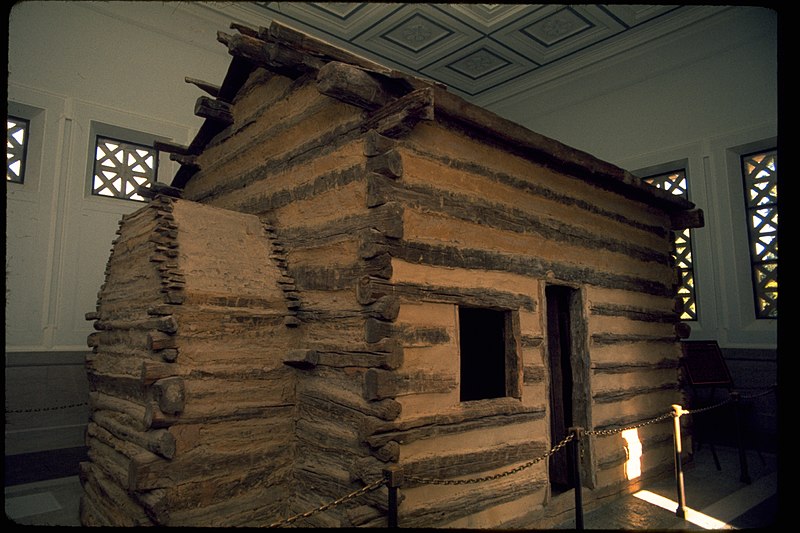A log cabin is a small log house, especially a less finished or architecturally sophisticated structure. Log cabins have an ancient history in Europe, and in America are often associated with first generation home building by settlers.
European History
Construction with logs was described by Roman architect Vitruvius Pollio in his architectural treatise De Architectura. He noted that in Pontus (modern-day northeastern Turkey), dwellings were constructed by laying logs horizontally overtop of each other and filling in the gaps with “chips and mud”.
Historically log cabin construction has its roots in Scandinavia and Eastern Europe. Although their origin is uncertain, the first log structures were probably being built in Northern Europe by the Bronze Age (about 3500 BC). C. A. Weslager describes Europeans as having:
Nevertheless, a medieval log cabin was considered movable property (a chattel house), as evidenced by the relocation of Espåby village in 1557: the buildings were simply disassembled, transported to a new location and reassembled. It was also common to replace individual logs damaged by dry rot as necessary.
The Wood Museum in Trondheim, Norway, displays fourteen different traditional profiles, but a basic form of log construction was used all over North Europe and Asia and later imported to America.
Log construction was especially suited to Scandinavia, where straight, tall tree trunks (pine and spruce) are readily available. With suitable tools, a log cabin can be erected from scratch in days by a family. As no chemical reaction is involved, such as hardening of mortar, a log cabin can be erected in any weather or season. Many older towns in Northern Scandinavia have been built exclusively out of log houses, which have been decorated by board paneling and wood cuttings. Today, construction of modern log cabins as leisure homes is a fully developed industry in Finland and Sweden. Modern log cabins often feature fiberglass insulation and are sold as prefabricated kits machined in a factory, rather than hand-built in the field like ancient log cabins.
Log cabins are mostly constructed without the use of nails and thus derive their stability from simple stacking, with only a few dowel joints for reinforcement. This is because a log cabin tends to compress slightly as it settles, over a few months or years. Nails would soon be out of alignment and torn out.
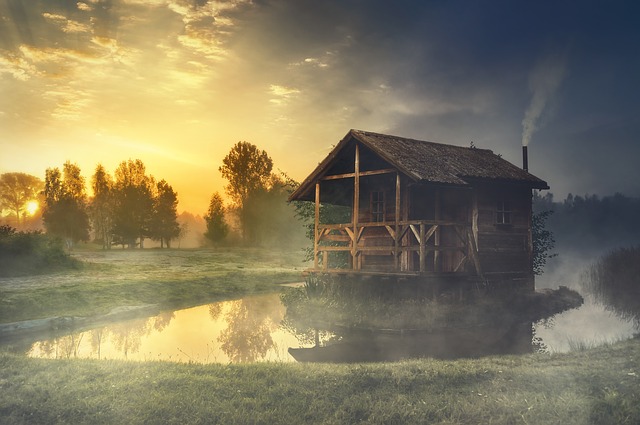
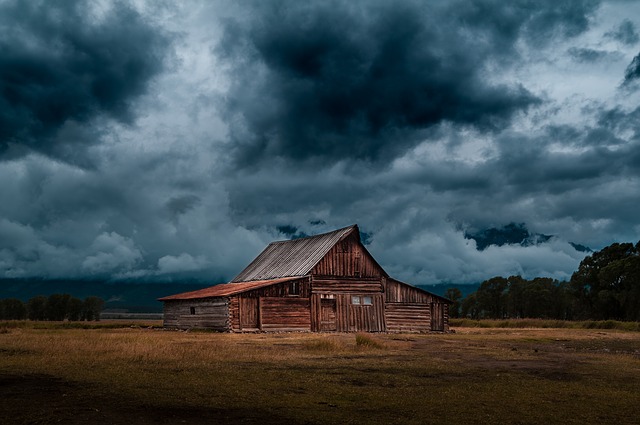
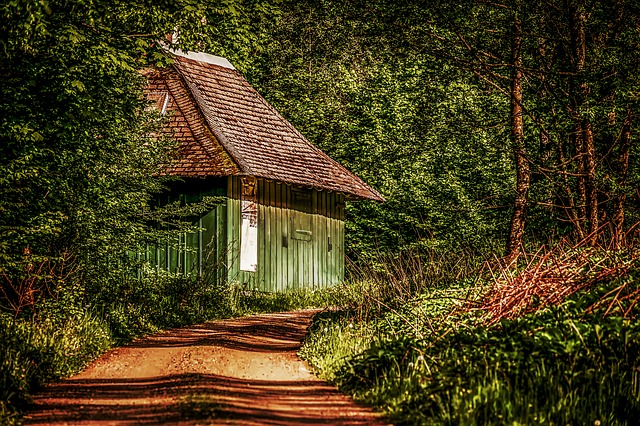
Traditional Log Buildings Europe and United States
In the present-day United States, settlers may have first constructed log cabins by 1638. Historians believe that the first log cabins built in North America were in the Swedish colony of Nya Sverige (New Sweden) in the Delaware River and Brandywine River valleys. Many of its colonists were actually Forest Finns, because Finland was part of Sweden at that time. New Sweden only briefly existed before it became the Dutch colony of New Netherland, which later became the English colony of New York. The Swedish-Finnish colonists’ quick and easy construction techniques not only remained, but spread.[citation needed]
Later German and Ukrainian immigrants also used this technique. The contemporaneous British settlers had no tradition of building with logs, but they quickly adopted the method. The first English settlers did not widely use log cabins, building in forms more traditional to them.[3] Few log cabins dating from the 18th century still stand, but they were often not intended as permanent dwellings. Possibly the oldest surviving log house in the United States is the C. A. Nothnagle Log House (ca. 1640) in New Jersey. Settlers often built log cabins as temporary homes to live in while constructing larger, permanent houses; then they often used the log cabins as outbuildings, such as barns or chicken coops.
Log cabins were built from logs laid horizontally and interlocked on the ends with notches (British English cog joints). Some log cabins were built without notches and simply nailed together, but this was not as structurally sound. Modern building methods allow this shortcut.
The most important aspect of cabin building is the site upon which the cabin was built. Site selection was aimed at providing the cabin inhabitants with both sunlight and drainage to make them better able to cope with the rigors of frontier life. Proper site selection placed the home in a location best suited to manage the farm or ranch. When the first pioneers built cabins, they were able to “cherry pick” the best logs for cabins. These were old-growth trees with few limbs (knots) and straight with little taper. Such logs did not need to be hewn to fit well together. Careful notching minimized the size of the gap between the logs and reduced the amount of chinking (sticks or rocks) or daubing (mud) needed to fill the gap. The length of one log was generally the length of one wall, although this was not a limitation for most good cabin builders.
Decisions had to be made about the type of cabin. Styles varied greatly from one part of the US to another: the size of the cabin, the number of stories, type of roof, the orientation of doors and windows all needed to be taken into account when the cabin was designed. In addition, the source of the logs, the source of stone and available labor, either human or animal, had to be considered. If timber sources were further away from the site, the cabin size might be limited.
Cabin corners were often set on large stones; if the cabin was large, other stones were used at other points along the sill (bottom log). Since they were usually cut into the sill, thresholds were supported with rock as well. These stones are found below the corners of many 18th-century cabins as they are restored. Cabins were set on foundations to keep them out of damp soil but also to allow for storage or basements to be constructed below the cabin. Cabins with earth floors had no need for foundations.
The modern version of a log cabin is the log home, which is a house built usually from milled logs. The logs are visible on the exterior and sometimes interior of the house. These cabins are mass manufactured, traditionally in Scandinavian countries and increasingly in eastern Europe. Squared milled logs are precut for easy assembly. Log homes are popular in rural areas, and even in some suburban locations. In many resort communities in the United States West, homes of log and stone measuring over 3,000 sq ft (280 m2) are not uncommon. These “kit” log homes are one of the largest consumers of logs in the Western United States.
In the United States, log homes have embodied a traditional approach to home building; one that has resonated throughout American history. It is especially interesting to discover that, in today’s world, log homes represent a technology that allows a home to be built with a high degree of sustainability. In fact, log homes are frequently considered to be on the leading edge of the green building movement.
Roofing
Log cabins were constructed with either a purlin roof structure or a rafter roof structure. A purlin roof consists of horizontal logs that are notched into the gable-wall logs. The latter are progressively shortened to form the characteristic triangular gable end. The steepness of the roof was determined by the reduction in size of each gable-wall log as well as the total number of gable-wall logs. Flatter roofed cabins might have had only 2 or 3 gable-wall logs while steeply pitched roofs might have had as many gable-wall logs as a full story. Issues related to eave overhang and a porch also influenced the layout of the cabin.
The decision about roof type often was based on the material for roofing like bark. Milled lumber was usually the most popular choice for rafter roofs in areas where it was available. These roofs typify many log cabins built in the 20th century, having full-cut 2×4 rafters covered with pine and cedar shingles. The purlin roofs found in rural settings and locations, where milled lumber was not available, often were covered with long hand-split shingles.
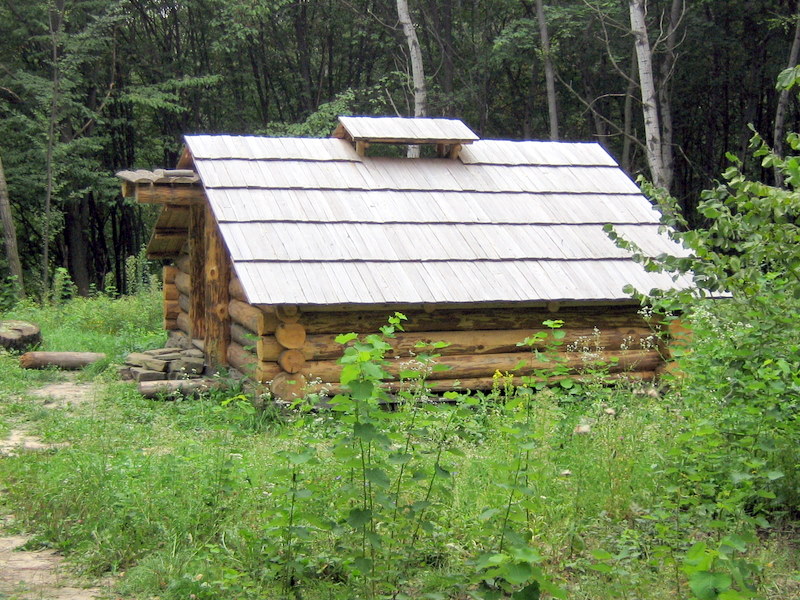
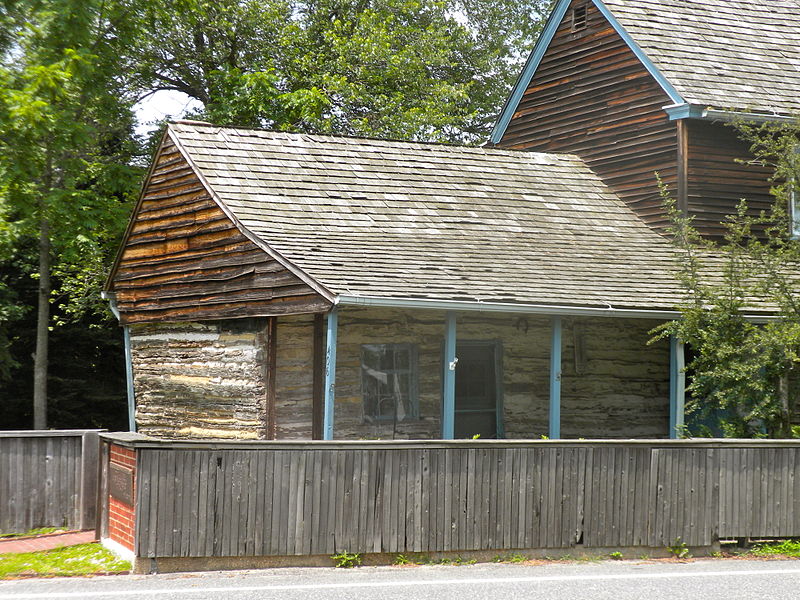
Symbolism
The log cabin has been a symbol of humble origins in US politics since the early 19th century. Seven United States Presidents were born in log cabins, including James Buchanan, Millard Fillmore, Andrew Jackson, Abraham Lincoln, Franklin Pierce, and James K. Polk.[4] Although William Henry Harrison was not one of them, he and the Whigs during the 1840 presidential election were the first to use a log cabin[5] as a symbol to show North Americans that he was a man of the people. Other candidates followed Harrison’s example, making the idea of a log cabin—and, more generally, a non-wealthy background—a recurring theme in campaign biographies.[6]
More than a century after Harrison, Adlai Stevenson acknowledged: “I wasn’t born in a log cabin. I didn’t work my way through school nor did I rise from rags to riches, and there’s no use trying to pretend I did.”[6] Stevenson lost the 1952 presidential election in a landslide to Dwight D. Eisenhower.
